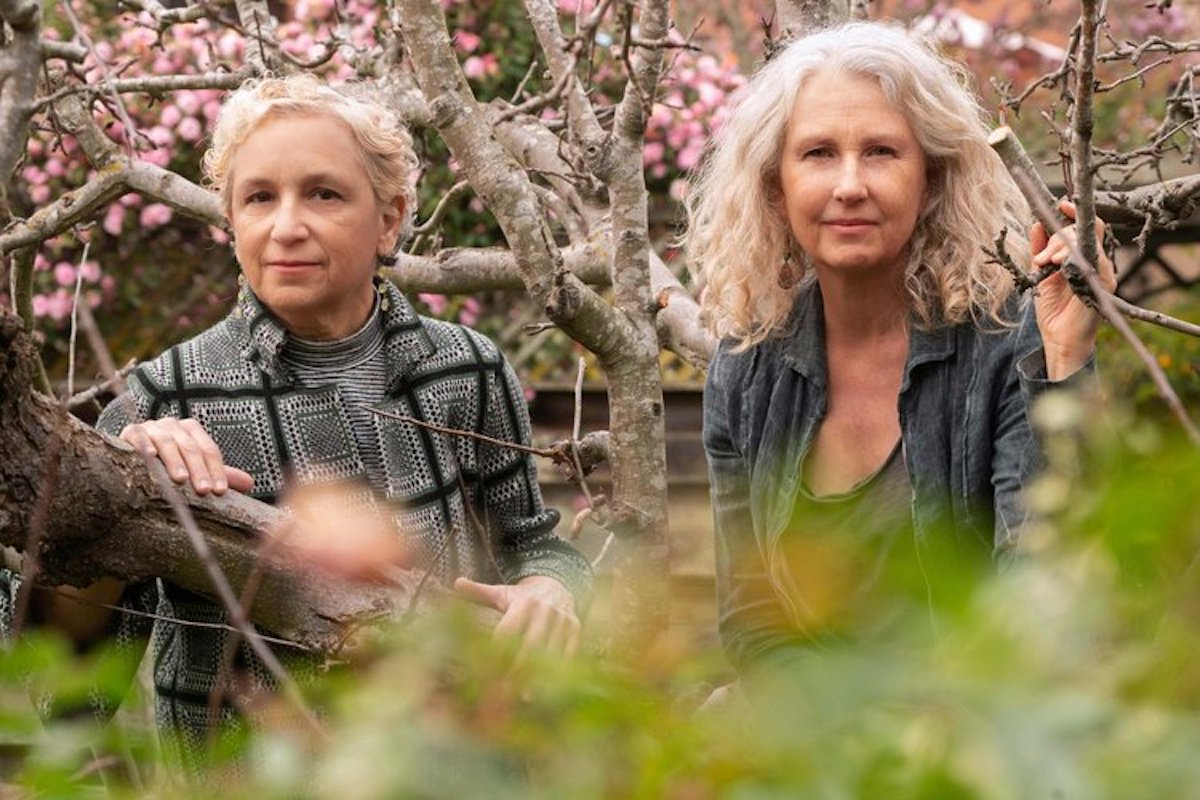
How can music help save the planet from environmental degradation? For violinists Irene Sazer and Kate Stenberg the path to preserving the Earth runs through Indigenous wisdom and scientific inquiry “amplified through art and beauty,” said Sazer, a longtime creative force in Berkeley.
Last year she and Stenberg launched The Mycos Project, a multidisciplinary collective that brings together multi-media artists, educators and scientists. They introduced the endeavor in March as part of InterMusic’s SF Music Day at Herbst Theatre performing a live score for their 22-minute film Not Apart, Together.
Braiding video, photo stills, and Sazer’s original art, the film captures arrestingly beautiful scenes of animals in the wild (like West Marin percussionist/photographer Deborah Fier’s mesmerizing murmuration footage) with commentary from an array of researchers and activists working to protect those habitats.
The violinists perform the improvised score live for the film’s East Bay premiere Tuesday at Berkeley’s Kala Art Institute, which presents it as part of a free event featuring environmental biologist Ravinder Sehgal and Ohlone leaders Corrina Gould, Ruth Orta, and Kanyon CoyoteWoman Sayers-Roods. Berkeley writer and educator Anna Lappé, a longtime advocate for food justice and sustainability, moderates the panel discussion.
Not apart, together, Nov. 15, 7 p.m., Kala Art Institute, 2990 San Pablo Ave.
For San Francisco-based Stenberg, an acclaimed champion of contemporary chamber music who performs regularly with Berkeley pianist Sarah Cahill, a passion for environmental stewardship dates back to high school. While sheltering in place during the early months of the pandemic “with more reflection time,” she said, “I wanted to tend to things that were important, the environment and global warming. After talking with some scientist friends I approached Irene about working on a project together. It’s something I care about so deeply and want to do my tiny little bit to bring awareness and help us move forward.”
The Mycos Project takes its name from the word “mycorrhiza,” the symbiotic association between plant roots and fungi. Stenberg and Sazer adopted the term as a metaphor for how all life is dependent on all other life, ideas threaded through Not Apart, Together, which was created with support from Kate Bermingham and the City of Berkeley’s Civic Arts Commission.
In many ways the project itself reflects the web of relationships that nurture and sustain the Bay Area arts scene. Sazer connected with Kala Art Institute about five years ago when she was doing a residency at Montalvo Arts Center in Saratoga. Mayumi Hamanaka, Kala’s artistic director, was also there with her husband, Taro Hattori, “a sculptor who builds these amazing conceptual installations,” said Sazer, who was working on her international commissioning project Culture Kin at the time.
“He was this other friendly artist there, and he recommended the artist who designed the Culture Kin album cover, Seiko Tachibana, who also did the beautiful background imagery for the live performance at Yerba Buena Center for the Arts. Then I started running into Mayumi all the time. Taro has worked with Kanyon CoyoteWoman, who’s on the Kala panel, and my son Jake did a graphic novel camp at Kala.”
Founded as Wilmot Street Studio by Archana Horsting and Yuzo Nakano in 1974 in a San Francisco Japantown alley, the printmaking atelier soon became the Kala Art Institute when they moved across the Bay to a space near the Ashby BART station. By 1979 Kala had taken over a new space in the historic Heinz Building, eventually establishing a 15,200-square-foot campus that includes a gallery facing San Pablo Avenue and studio space “for artists in residence, and classes for adults, youths and teens,” Hamanaka said. “The main focus is visual arts, but there’s a lot of interdisciplinary work by artists who work in sound and video and installation.”
With support from neighboring Meyer Sound, Kala used to present a variety of concerts, from violin and piano recitals to sound installations. Sazer and Stenberg’s performance is the institute’s first live music event since the advent of the pandemic. “Everything else has been back for a while,” Hamanaka said. “We have a very active education program, exhibitions are open, and there are events coming up. We’re back to normal, and it’s really exciting that music is coming back too.”
Not Apart, Together features a score that Sazer and Stenberg recorded, music they augment in real time. Veteran improvisers — Sazer was an early member of the pioneering jazz string ensemble Turtle Island String Quartet — they have an inordinate amount of fun accompanying the film’s feathered hijinks.
“The murmurations are so musical in themselves, and to see those pelicans moving in time, in slo mo, is also very musical,” Stenberg said. “With each episode and sequence, the music we play with the film changes.”
As a creative outlet and an ongoing conversation the Mycos Project is just getting started.
“We have our next film project, which we’re thinking will focus on coral reefs,” Sazer said, “collaborating with a Hawaiian artist or two.”
Recommended gig
Oakland saxophonist and visual artist Georgianna Krieger celebrates the release of her new album Embrace Saturday at the Back Room with a talent-packed ensemble. She wrote a set of sublimely lyrical composition while sheltering in place during the first year of the pandemic, music that she says “straddles the space between cool jazz and popular music genres…influenced by my love of jazz and fusion.” An expert reed player who also performs with Melba’s Kitchen, Krieger plays soprano, alto and baritone saxophones. Her all-acoustic combo features the Melba’s Kitchen rhythm section tandem of Berkeley percussionist Renaye Brown and bassist Susanne DiVincenzo, bassist Ted Burik, drummer Greg German, pianist Gaea Schell and guest soloists including cellist Nancy Bien, vibraphonist Dave Casini, flugelhornist Helena Jack, violinist Michele Walther, and flutist Laura Austin Wiley. She illustrated an “album cover” for each track that are available as limited edition prints.
